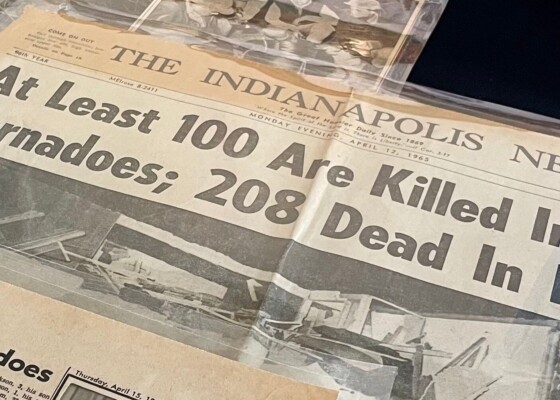Visiting a piece of forever
August 19, 2016We meet in Muncie at the Historic Wysor Street Depot. No trains whistle. The only sounds are the pings and snaps of bikes being unloaded from cars and trucks. The…
We meet in Muncie at the Historic Wysor Street Depot. No trains whistle. The only sounds are the pings and snaps of bikes being unloaded from cars and trucks. The rail bed, straight with imperceptible rises and declines, is paved now to form the Cardinal Greenway, and takes us nine miles south of town to Red-Tail Nature Preserve, the first parcel acquired by Red-Tail Land Conservancy at its formation in 1999. Then, the land was a weedy, rolling farm field, and now it’s a functioning, vibrant prairie.
****
Hiking into the prairie, the tallest grasses are at eye level or above, and the thick ecosystem runs in all directions. We think of prairies as something we see further west, but Indiana had many areas of prairie, and many are being restored. Other parts of the western landscape—mountains and deserts—aren’t present in Indiana, but as Ann Zwinger writes in “Remembering Indiana” in The Near-sighted Naturalist, published in 1998, “I came to a western landscape as an outsider looking in. I could do so because in Indiana I had learned how to be an insider looking out.”
She grew up along the White River in Muncie, and she refers to Indiana as her “‘type location,’ as a geologist would say, for judging and evaluating the rest of the world. The West is the West because of what I remember about Indiana.” For the hikers on the trip, “type locations” include Pennsylvania, Virginia, California, or Colorado. Within Indiana, those places are the Flat Rock River YMCA camp, Big Walnut Creek, or nondescript farm fields and wood lots.
****
Memory is integral to landscape–memory of the land and what was there, and our own memories of interacting with a landscape. In “The Robin Moth: Cecropia” from The Moths of the Limberlost, published in 1912, Gene Stratton-Porter writes about first seeing the robin moth and her deep love for and obsession with the birds, plants, and animals around her. “Of course I thought it was a butterfly, and for a time was too filled with wonder to move. Then creeping close, the time the wings were raised above its body, with the nerveless touch of a robust child I captured it.” Her early childhood obsession turned into a career in writing, photography, and movies.
For those on the hike, seminal, transformative memories include a mother raccoon in tree, spiders crossing road for a mile, taking water down to dry creek in a dry summer, the first warm rain of March, crawdads emerging and other signs of spring, and earthworms on sidewalk in the city.
Around us, we could see no sign that this prairie used to be a farm field, but we can imagine the memory of it.
****
Another sort of memory we discuss are memories of night, taking inspiration from the “The Orchid Ridges” chapter in Edwin Way Teale’s Journey into Summer, published in 1960. Teale won the 1966 Pulitzer Prize in General Nonfiction for his book, Wandering Through Winter.
We first talk of heat lightning, but soon focus more on sounds than sights. There is too much noise in the day, and it’s easier to focus on a single sound at night.
Along the Knobstone Trail, there are lots of sounds when night begins, then quiet, and then before night ends, the early morning noise is totally different.
Wetlands at night are noisy: bullfrogs, spring peepers, a half-dozen tree frogs calling to each other. Owls punctuate the noise of the frogs. Cicadas lend an underlying buzz to it all.
The degree of sounds: frogs are louder than insects, and together, they are louder than birds like nighthawks.
Sounds of winter: cracking of snow in silence. Or a snow fort at night. The stars. The quiet. The snow walls absorbing any sound.
A pool with frogs at night.
Returning to a vision: the relaxing acrobatics of bats—acro-bat-tics.
****
We return to the sitting area at the preserve for sandwiches and drinks and Upland Brewing Co. beers and discuss two ideas that Aldo Leopold writes about in “A Prairie Birthday” in A Sand County Almanac, published in 1949. “There are idle spots on every farm, and every highway is bordered by an idle strip as long as it is.” We first discuss idle spots, such as the Tipton High School Nature Center that has gone wild. The spaces near and between some subdivisions are idle spots. Other idle spots include big backyards, a woods in a park in Cambridge City, or a house in the woods. A favorite idle spot is Bacon Swamp in Indianapolis. Other idle spots include Minnetrista in Muncie or Falls of the Ohio, places with a long history of human inhabitation.
Another idea from Leopold is linear reservations. “The outstanding conservator of prairie flora, ironically enough, knows little and cares less about such frivolities: it is the railroad with its fenced right-of-way…. Within these linear reservations, oblivious of cinders, soot, and annual clean-up fires, the prairie flora still splashes its calendar of colors, from pink shooting-star in May to blue aster in October.” Linear reservations include the Cardinal Greenway and many other rail-trail projects in the state. Just west of the small town Hillisburg in eastern Clinton County, a small prairie persists along the rail line.
Rivers and creeks are also linear reservations, and the Healthy Rivers Initiative is working to link large tracts of preserved land along the Wabash River, Sugar Creek in western Indiana, and the Muscatatuck River in southern Indiana. An outcome of these projects is creating corridors that wildlife can use to migrate, to find better habitat, and to colonize recovering habit.
Another type of linear reservation is conservation easements, some of which will preserve farm fields along Highway 13 near Elwood.
****
We also read “Muncie Creek” by Sean Lovelace, a piece of flash fiction he wrote for the Upper White River Watershed Bookmap. We ended with this because a fiction is a vision or an imagining that can turn to truth or reality. In a way, the Red-Tail Nature Preserve was once a fiction, a vision that is now a truth that we can walk through and experience.
A fiction that turns to truth can also be seen in the work on the Bicentennial Nature Trust, the Healthy Rivers Initiative, and the work of land trusts across Indiana. Land trusts like Red-Tail Land Conservancy will preserve land in perpetuity. Many preserved lands like state forests or parks can be logged, mined, etc., but land trusts protect the land forever. To preserve that land, they and other land trusts need funding for stewardship, acquisitions, and education.
Other acts of imagination include career changes to work in environmental education, hope for natural areas and improved attitudes toward them in the Rust Belt, and a responsibility to maintain what we have, including saving old trees by cabling and planting new trees in our older neighborhoods. For the next generation, we need to pay attention now. Park spending per resident is low in Indianapolis and around the state, and we can work to make it higher.
Another fiction that can turn to truth is increasing kids’ access to nature for wellness and outdoor experience. Contact now means they will love and respect it in the future. Either people grew up in nature or they had a nature mentor, and that mentorship can be shared via volunteers. That interaction can happen in urban or suburban areas and doesn’t have to be in a nature preserve. The Red-Tail Land Conservancy is engaging in more of this work, and the Next Indiana Campfires is promoting it as well.
The work of land trusts is forever, and with that idea, we left our brief visit to a small piece of eternity, pedaling our bikes back and following a long, straight line mounded from the nearby plain.


